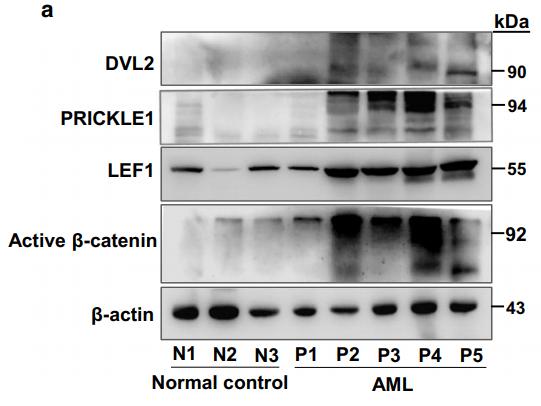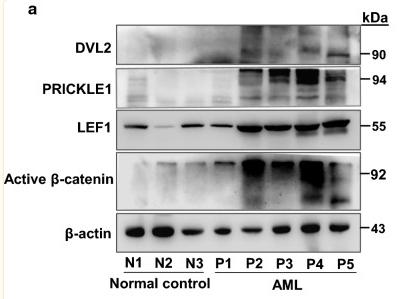产品描述
*The optimal dilutions should be determined by the end user.
*Tips:
WB: 适用于变性蛋白样本的免疫印迹检测. IHC: 适用于组织样本的石蜡(IHC-p)或冰冻(IHC-f)切片样本的免疫组化/荧光检测. IF/ICC: 适用于细胞样本的荧光检测. ELISA(peptide): 适用于抗原肽的ELISA检测.
引用格式: Affinity Biosciences Cat# DF4454, RRID:AB_2836809.
展开/折叠
Dishevelled 2 (homologous to Drosophila dsh); Dishevelled dsh homolog 2; dishevelled segment polarity protein 2; Dishevelled-2; Dishevelled2; DSH homolog 2; DVL 2; Dvl2; DVL2_HUMAN; Segment polarity protein dishevelled homolog DVL 2; Segment polarity protein dishevelled homolog DVL-2; Segment polarity protein dishevelled homolog DVL2;
抗原和靶标
- O14641 DVL2_HUMAN:
- Protein BLAST With
- NCBI/
- ExPASy/
- Uniprot
MAGSSTGGGGVGETKVIYHLDEEETPYLVKIPVPAERITLGDFKSVLQRPAGAKYFFKSMDQDFGVVKEEISDDNARLPCFNGRVVSWLVSSDNPQPEMAPPVHEPRAELAPPAPPLPPLPPERTSGIGDSRPPSFHPNVSSSHENLEPETETESVVSLRRERPRRRDSSEHGAGGHRTGGPSRLERHLAGYESSSTLMTSELESTSLGDSDEEDTMSRFSSSTEQSSASRLLKRHRRRRKQRPPRLERTSSFSSVTDSTMSLNIITVTLNMEKYNFLGISIVGQSNERGDGGIYIGSIMKGGAVAADGRIEPGDMLLQVNDMNFENMSNDDAVRVLRDIVHKPGPIVLTVAKCWDPSPQAYFTLPRNEPIQPIDPAAWVSHSAALTGTFPAYPGSSSMSTITSGSSLPDGCEGRGLSVHTDMASVTKAMAAPESGLEVRDRMWLKITIPNAFLGSDVVDWLYHHVEGFPERREARKYASGLLKAGLIRHTVNKITFSEQCYYVFGDLSGGCESYLVNLSLNDNDGSSGASDQDTLAPLPGATPWPLLPTFSYQYPAPHPYSPQPPPYHELSSYTYGGGSASSQHSEGSRSSGSTRSDGGAGRTGRPEERAPESKSGSGSESEPSSRGGSLRRGGEASGTSDGGPPPSRGSTGGAPNLRAHPGLHPYGPPPGMALPYNPMMVVMMPPPPPPVPPAVQPPGAPPVRDLGSVPPELTASRQSFHMAMGNPSEFFVDVM
种属预测
score>80的预测可信度较高,可尝试用于WB检测。*预测模型主要基于免疫原序列比对,结果仅作参考,不作为质保凭据。
High(score>80) Medium(80>score>50) Low(score<50) No confidence
研究背景
Plays a role in the signal transduction pathways mediated by multiple Wnt genes. Participates both in canonical and non-canonical Wnt signaling by binding to the cytoplasmic C-terminus of frizzled family members and transducing the Wnt signal to down-stream effectors. Promotes internalization and degradation of frizzled proteins upon Wnt signaling.
Phosphorylated by CSNK1D. WNT3A induces DVL2 phosphorylation by CSNK1E and MARK kinases.
Cell membrane>Peripheral membrane protein>Cytoplasmic side. Cytoplasm>Cytosol. Cytoplasmic vesicle. Nucleus.
Note: Localizes at the cell membrane upon interaction with frizzled family members and promotes their internalization. Localizes to cytoplasmic puncta (By similarity). Interaction with FOXK1 and FOXK2 induces nuclear translocation (PubMed:25805136).
Interacts through its PDZ domain with the C-terminal regions of VANGL1 and VANGL2. Interacts with Rac. Interacts with ARRB1; the interaction is enhanced by phosphorylation of DVL1 (By similarity). Can form large oligomers (via DIX domain). Interacts (via DIX domain) with DIXDC1 (via DIX domain). Interacts (via DEP domain) with AP2M1 and the AP-2 complex (By similarity). Interacts with DACT1 and FAM105B/otulin. Interacts with DCDC2. Interacts (when phosphorylated) with FOXK1 and FOXK2; the interaction induces DVL2 nuclear translocation. Interacts with MAPK15 (By similarity). Interacts with PKD1 (via extracellular domain). Interacts with LMBR1L (By similarity).
The DIX domain mediates homooligomerization.
Belongs to the DSH family.
研究领域
· Cellular Processes > Cellular community - eukaryotes > Signaling pathways regulating pluripotency of stem cells. (View pathway)
· Environmental Information Processing > Signal transduction > mTOR signaling pathway. (View pathway)
· Environmental Information Processing > Signal transduction > Wnt signaling pathway. (View pathway)
· Environmental Information Processing > Signal transduction > Notch signaling pathway. (View pathway)
· Environmental Information Processing > Signal transduction > Hippo signaling pathway. (View pathway)
· Human Diseases > Infectious diseases: Viral > Human papillomavirus infection.
· Human Diseases > Infectious diseases: Viral > HTLV-I infection.
· Human Diseases > Cancers: Overview > Pathways in cancer. (View pathway)
· Human Diseases > Cancers: Specific types > Basal cell carcinoma. (View pathway)
· Human Diseases > Cancers: Specific types > Breast cancer. (View pathway)
· Human Diseases > Cancers: Specific types > Hepatocellular carcinoma. (View pathway)
· Human Diseases > Cancers: Specific types > Gastric cancer. (View pathway)
· Organismal Systems > Endocrine system > Melanogenesis.
文献引用
Application: WB Species: human Sample:
Application: WB Species: Human Sample:
限制条款
产品的规格、报价、验证数据请以官网为准,官网链接:www.affbiotech.com | www.affbiotech.cn(简体中文)| www.affbiotech.jp(日本語)产品的数据信息为Affinity所有,未经授权不得收集Affinity官网数据或资料用于商业用途,对抄袭产品数据的行为我们将保留诉诸法律的权利。
产品相关数据会因产品批次、产品检测情况随时调整,如您已订购该产品,请以订购时随货说明书为准,否则请以官网内容为准,官网内容有改动时恕不另行通知。
Affinity保证所销售产品均经过严格质量检测。如您购买的商品在规定时间内出现问题需要售后时,请您在Affinity官方渠道提交售后申请。产品仅供科学研究使用。不用于诊断和治疗。
产品未经授权不得转售。
Affinity Biosciences将不会对在使用我们的产品时可能发生的专利侵权或其他侵权行为负责。Affinity Biosciences, Affinity Biosciences标志和所有其他商标所有权归Affinity Biosciences LTD.




